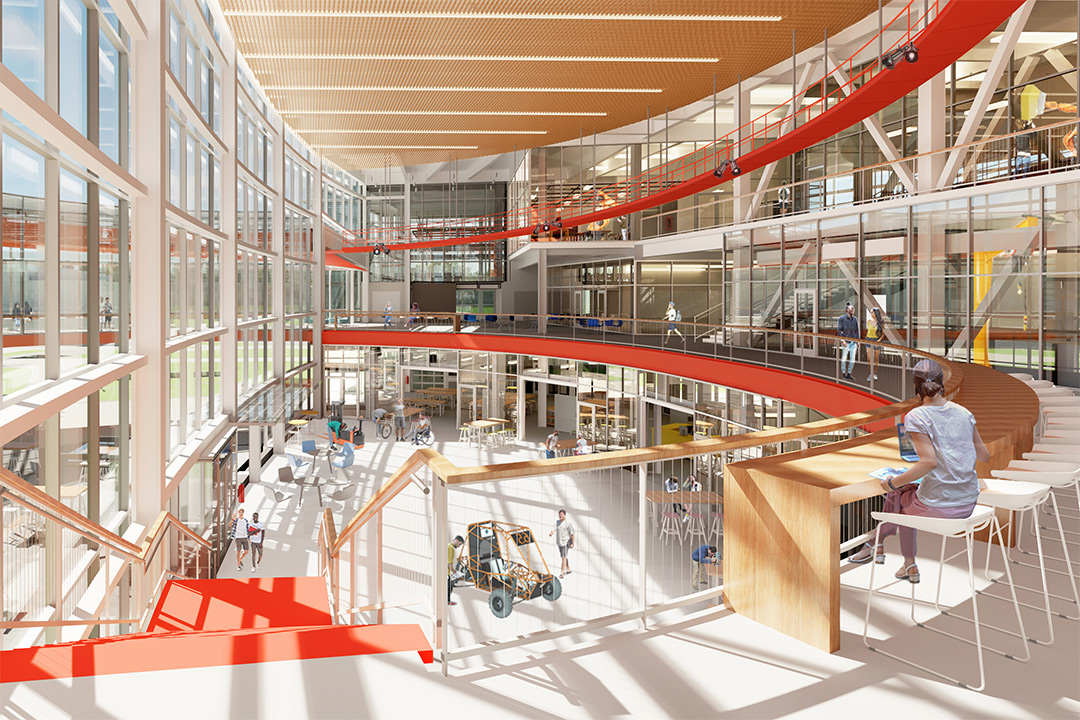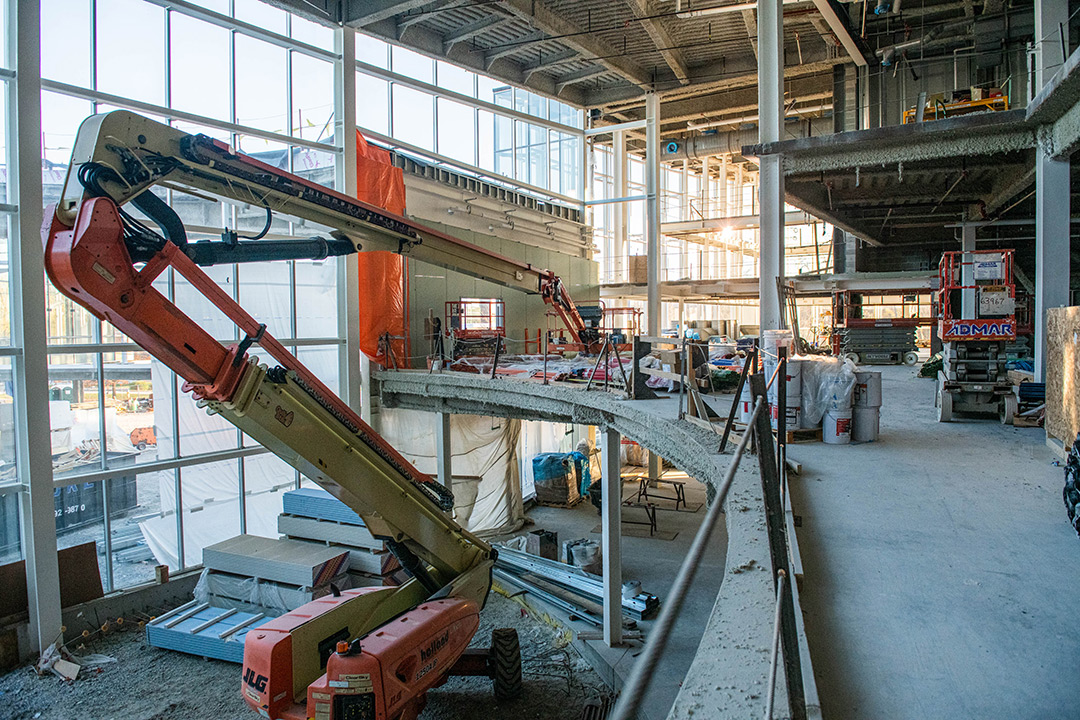SHED will showcase RIT maker community
William Rawn Associates
A design rendering showing a common space in the SHED overlooking the A-level.
Nearly 70 different RIT student teams and clubs are poised to move into the Student Hall for Exploration and Development (SHED) this summer in preparation for the building’s official opening in the fall semester. The SHED will centralize RIT’s maker community and bring together many of the performance teams, various other maker clubs and organizations, and a growing number of performing arts groups.
The SHED’s glass construction will showcase student creativity, encapsulating RIT’s unique blend of technology, the arts, and design, envisioned by RIT President David Munson. Passersby and visitors to campus will see students busy at work on three levels of maker spaces, starting with the A-level, and in extra-large classrooms located on the third and fourth floors.
The A-level is split into two zones that will house, on one side, an open maker space and wood and metal shops, and on the other, seven of RIT’s performance teams that participate in national and international competitions.
Gabrielle Plucknette-DeVito
The interior of the SHED is starting to take shape. Student groups will be found throughout the building.
Thirty clubs and organizations will use the three floors of thematic maker spaces, and another 30 performing arts groups will use the music rehearsal rooms, dance studios, and the Sklarsky Glass Box Theater. Close proximity of the different teams and clubs is meant to inspire cross-pollination and collaboration throughout the building, according to Michael Buffalin IV, director of the SHED makerspace.
“One team might be really great in composites and another might be starting to dabble in that, and having them co-located you see this sharing of talent and ideas that will hopefully accelerate some of these teams’ abilities,” Buffalin said.
Soon after the SHED project was announced, a cross-divisional planning team, led by Christine Licata, RIT vice provost for academic affairs, asked students in performance teams, clubs, and organizations to share their vision for how they might use space in the new building. While many students consulted in the beginning of the project have since graduated, their feedback—from having a place to meet and work or practice, and access to technology and storage space—helped the SHED planning group imagine how student teams, clubs, and organizations would populate the facility.
An additional seven resident performance teams on the A-level are grouped in “neighborhoods”—electric vehicles (Hot Wheelz and the Electric Vehicle Team), robotics (VEX and Multi-Disciplinary Robot Club), and aerospace (Launch Initiative and Aero Design), and the Steel Bridge team will occupy its own space. The SHED planning group selected these teams based on criteria developed by the president and provost to ensure representation across different kinds of teams at RIT, Licata said.
High-profile performance teams that operate internal combustion engines requiring additional room and infrastructure with special ventilation—Baja, Formula One, and Clean Snowmobile—will remain in their existing machine shops located in the Kate Gleason College of Engineering and in Slaughter Hall. The SHED’s Brooks H. Brower Maker Showcase will showcase vehicles from previous competitions.
Input from student teams and from Student Government, which funds the clubs, is key to the success of the SHED, said Martin Gordon, professor of manufacturing and mechanical engineering technology. “We don’t want to build it and see if they come. We want to build it and hit the ground running.”
A residency board will give the teams a voice and review occupancy. “There are clubs that don’t even exist today that will find themselves in there,” Gordon said.
The first floor of the SHED will hold a collaborative maker space and a classroom maker space, Buffalin said. He explained that the thematic maker spaces on the A-level, and first and second floors are intended to support the evolution of an idea. Different technologies will facilitate ideation, prototyping, building, and testing, including core- and 3D printing, woodworking, metalworking, textiles, and electronics. Various teams will use each maker space, and some teams might discover new applications they hadn’t previously considered, Buffalin said.
The maker spaces will be open to clubs on campus and for students looking to join or form a new club.
“We look at heavy users of our metal shops and that may be more of the performance teams located on our A-level,” Buffalin said. “Then, we look at our textiles and electronics space, and the performing arts groups could be super-users in that area. On any given day, they might share the space with the Neurotechnology Exploration Team, for instance, making a wearable brain-computer-interface system, and alongside a senior design team sewing vinyl floating pontoons.”
Performing artists will have a large presence in the SHED through music, dance, and theater classes, and clubs. When classes aren’t in session, student performing arts clubs can reserve the dance studios and ensemble rooms, including a “plug-and-play” room for musicians to experiment and record their sessions, and five sound-proof rehearsal rooms on the A-level.
The creative potential of 3D printing capabilities, textiles, woodworking, augmented reality/virtual reality, projections, and motion-capture technology for theater set design present new possibilities for productions in the Sklarsky Glass Box Theater, said Ben Willmott, operations director for performing arts in the School of Performing Arts. “The SHED will allow us to go down this innovative path in ways we have not been able to do in the past.”
The new learning spaces present new possibilities to schedule RIT/NTID performing arts courses, such as a fall semester costume class. Willmott and Buffalin are exploring hosting the class in the SHED’s textile maker space.
“That will be a natural collaboration and partnership,” Willmott said.
The SHED was made possible by Transforming RIT: The Campaign for Greatness, a blended fundraising campaign.







